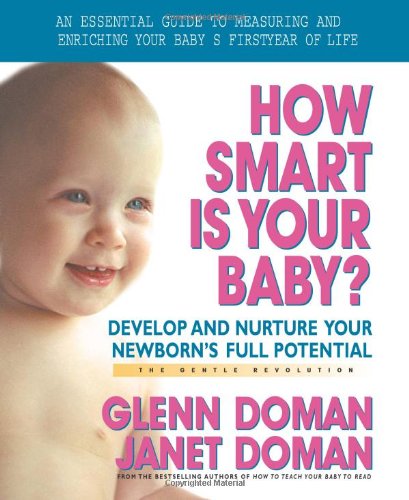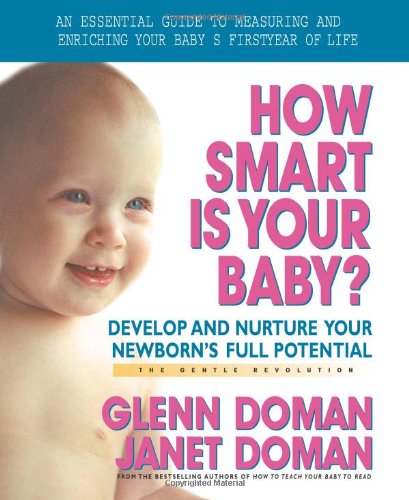The first months after birth are vital to the long-term well-being of a child. Yet parents do not have the information they need to make their baby’s life as stimulating as it should be. How Smart Is Your Baby? provides parents with all the information required to help their baby achieve full potential. The authors first explain infant growth, and then guide parents in creating a home environment that enhances brain development. A developmental profile allows parents to track their child’s progress, determine strengths, and recognize where additional stimulation is needed.
Glenn Doman received his degree in physical therapy from the University of Pennsylvania in 1940. From that point on, he began pioneering the field of child brain development. In 1955, he founded The Institutes' world-renowned work with brain-injured children had led to vital discoveries regarding the growth and development of well children. The author has lived with, studied, and worked with children in more than one hundred nations, ranging from the most civilized to the most primitive. Doman is also the international best-selling author of six books, all part of the Gentle Revolution Series, including How To Teach Yor Baby To Read, How To Teach Your Baby Math, and How To Give Your Baby Encyclopedic Knowledge.
Janet Doman is the director of The Institutes and Glenn’s daughter. She was actively involved in helping brain-injured children by the time she was nine years old, and after completing her studies at the University of Pennsylvania, devoted herself to helping parents discover the vast potential of their babies and their own potential as teachers.
Contents
Acknowledgments
Foreword
Introduction
1. What Mothers Know
2. The Search for Wellness
3. A New Kind of Kid
4. About the Brain
5. The Newborn Baby
6. Making the Alarm Clock Go Off
7. The Institutes Developmental Profile
8. Evaluating Your Newborn Baby
9. The Sensory Program for Your Newborn
10. The Motor Opportunity Program for Your Newborn
11. Your Baby’s Second Evaluation
12. Expanding Your Sensory Program
13. Expanding Your Motor Opportunity Program
14. The Language Development Program from Birth to 12 Months
15. The Third Evaluation: Meaningful Appreciation and Response
16. The Sensory Stimulation Program for Stage III
17. The Motor Opportunity Program for Stage III
18. The Fourth Evaluation
19. The Sensory Stimulation Program for Stage IV
20. The Motor Opportunity Program for Stage IV
21. What To Do and What Not To Do
22. The Gentle Revolution
Afterword
About Our Babies
About The Institutes
About the Authors
Appendix A: Resources
Appendix B: A Reassessment of the SIDS Back to Sleep
Campaign
Appendix C: Equipment You Can Build and Make for Your Baby
Index
Introduction
The majestic organ that is the brain starts developing in utero. Although learning continues throughout life, there is a special window of opportunity for permanent brain growth and special learning that occurs in the first year of life. The newborn period, or first few weeks, is a remarkable time and incredible things are occurring. This is not just a passive beginning; it is the explosive start to learning and brain growth. During the first year the baby’s amazing growth and learning continues. The baby’s brain is rapidly growing, which is reflected in the astonishing changes in head circumference. This period is vitally important for brain development. Doctors, scientists, and educators now acknowledge that the first several years of life is a critical time for the acquisition of skills—and that appropriate stimulation and experience is critical to optimizing a child’s growth and development.
These early years are extremely important. It is now recognized that the sooner the baby receives sensory stimulation and opportunity for mobility and language expression, the more likely that brain growth, development, and skills will be optimized. It is important to understand how this occurs in order to maximize your understanding of the programs in this book. The baby in utero is creating billions and billions of brain cells prior to birth.
Those brain cells only await stimulation to create networks of function that will allow the child to see, hear, feel, taste, and smell, and the experience that develops mobility, language, and manual ability.
The normal newborn will have some basic functions at birth, but must incorporate sensory stimulation and motor experience in order to grow or enhance these functions and learn or make associations.
When an object is perceived by the five sensory pathways and gains meaning for the baby, a type of learning has taken place.
The newborn must also learn to integrate sensory information in order to produce coordinated mobility, sounds, and manual competence.
Sensory pathways must supply information to association areas, to primary sensory decoding areas, and to memory and planning areas of the brain in order to produce proper output (such as motor action). The motor pathways (mobility, language, and manual competence) must be monitored by the sensory pathways to refine output.
In the healthy “normal” newborn, this is a wonderful cycle that reinforces learning. In the brain-injured newborn, this may be a vicious cycle in which poor sensory input will result in poor or inappropriate output.
A premature newborn has earlier access to sensory stimulation than the term infant who is still in utero. For example, the premature baby has the advantage of seeing light-dark contrast while the baby in utero does not have access to such stimulation. Visual maturation begins immediately for the premature infant.
In the newborn, the brain is undergoing three natural but important processes that we can call pruning, learning, and myelination.
Pruning is an interesting and basic brain phenomenon. In the young baby, billions and billions of brain cells are in place at birth. However, only those brain cells that are used and properly stimulated with sufficient frequency, intensity, and duration early on will be reinforced and become permanent neurological connections functioning as important circuits or networks. Those that are not sufficiently used are “pruned.” That is, if they are not used they die away.
Unfortunately, there have been cases of children who were born with essentially “normal” or uninjured brains who have been placed in environments of sensory deprivation and lost the opportunity to develop significant abilities. Some have been in overcrowded orphanages. Others have been in caring homes, but due to a lack of knowledge on the part of the parents or caretakers these babies have been placed in bland, uninteresting, quiet, unstimulating environments and received little sensory stimulation or motor opportunity.
They may have been confined to baby carriers, cribs, walkers, or other restrictive devices that do not permit free movement and appropriate sensory-motor stimulation and integration.
Studies have shown that children placed in walkers can be developmentally delayed compared to children who are allowed to crawl, creep, and walk in a safe environment. In addition, devices like walkers are a leading cause of injury in young children. To the degree that a newborn is deprived of sensory stimulation or motor experience and opportunity for expression, the baby will lose the opportunity for some function.
While the pruning of brain cells may appear to be a harsh or unproductive phenomenon, it represents the realities of brain-body economy. The brain requires a constant, high-quality source of energy and nutrients, and an astonishing twenty percent of all incoming oxygen. Those areas that are not used are shut down to send these resources elsewhere as needed.
At the same time pruning is occurring, its opposite, learning, occurs. This reinforcement of brain neural circuits allows the permanent acquisition of neural networks if proper stimulation is given.
Myelination is also occurring. This process, in which neurons develop the insulated covering on their processes, helps establish connections and speeds up information exchange. Simply put, the brain grows by use and one must “use it or lose it.”
But how does the brain work?
Can it be influenced for the better?
Why are the newborn and infancy periods so special?
How does the brain and nervous system develop?
What does the brain and nervous system do?
How does it function?
What can a mother do to help the process of sensory and motor development?
Could mother unknowingly do something that might inhibit or stop optimal development of the brain?
Is your child well?
Is your child normal?
What is normal?
If your child has an injury to the brain, how can you recognize this?
How can you help your baby if he does have a problem?
These and dozens of other questions run through the minds of concerned parents. The Institutes for the Achievement of Human Potential, founded in 1955 by Glenn Doman, has been posing these questions and finding the answers for a half-century.
This book explains exactly how to evaluate the sensory and motor pathways of the baby and exactly how to design a program that will enhance the growth and development of these pathways. It is an inspired guided tour of the first twelve months of brain growth and development.
All of the information in this book is presented so that any mother and father, without a medical background, can benefit from it. In it we gain a sense of what the world may look like and feel like to our newborns. We acquire a better understanding of the challenges and frustrations the newborn experiences. Armed with this knowledge, we know what our baby needs and wants and we can have the great joy of creating an ideal environment for him.
Every day is precious, and your baby is hungry for knowledge about the world around him, starting from the moment of birth. To feed your child’s brain is as important as feeding his stomach.
The goal of this book is to help parents understand the brain and nervous system. Parents may then follow a clear pathway to enhance the abilities of their child. This is not only an extremely important process—it is also a very joyous one for mother and baby.
—Denise Malkowicz, M.D.





